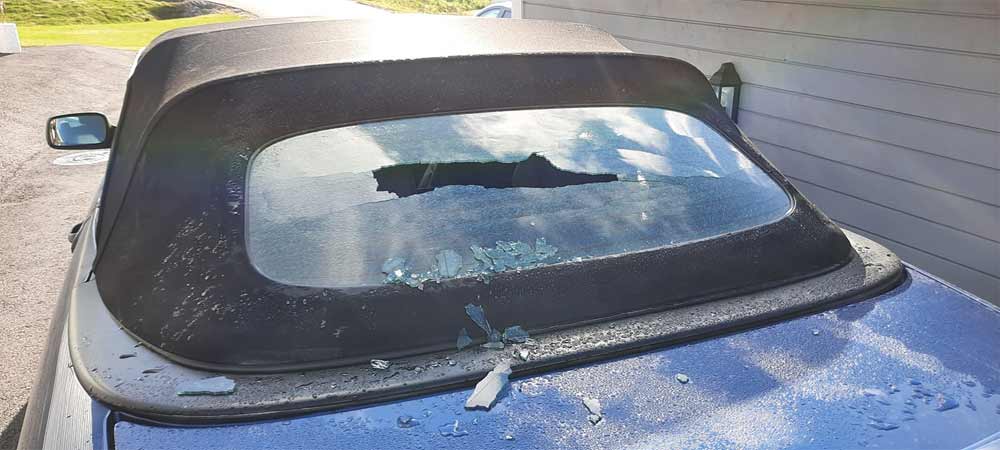Auto glass, particularly in vehicles like the Saab Convertible, is susceptible to damage due to extreme temperature variations. This issue is not exclusive to Saab models like the SportWagon and SportSedan, but is more pronounced in convertibles due to their integrated rear glass in the folding soft-top, making replacement more complex and costly.
Table of Contents
The Physics Behind the Problem
The primary cause of glass cracking, especially in colder climates, is the rapid heating of the glass through defrosters or other heat sources. Imagine a scenario where your car, like a Saab Convertible, has been parked overnight in sub-zero temperatures (-10°C).
Upon starting the car and activating the rear defroster for de-icing, the powerful heater quickly warms the glass. This rapid temperature change, particularly around the metal filaments in the glass, leads to cracking due to the immense thermal stress.

Similarly, inexperienced drivers might pour hot water on the windshield to de-ice it quickly, risking cracks or shattering. This is akin to the phenomenon observed in car washes during extreme weather, where sudden temperature shifts can cause existing minor damages like rock chips to expand, leading to significant glass damage.
Why Does This Happen?
Auto glass is tempered for safety, designed to break into small granules to reduce injury risk. However, this tempering process pre-stresses the glass, making it more vulnerable to other stresses such as impacts, scratches, or flexing – a frequent issue for convertibles. Age further exacerbates this vulnerability, as older glass is generally more susceptible to stress failures.
Preventive Measures and Maintenance Tips
To minimize the risk of glass damage:
- Avoid Extreme Temperature Changes: Gradually warm up the car and defrost the windows. Avoid using hot water for de-icing.
- Regular Inspections: Check for any minor damages or scratches, as these can become starting points for larger cracks.
- Gentle Cleaning and Maintenance: Use appropriate cleaning agents and soft cloths to clean the glass. Harsh chemicals or abrasive materials can weaken the glass.
- Consider Environment: Park in shaded areas during summer and use car covers in winter to moderate the glass temperature.
- Professional Consultation: For older vehicles, especially convertibles like the Saab, consult with professionals regarding glass maintenance and potential preventive replacements.
Understanding the thermodynamic principles behind glass damage in automobiles, especially in specific models like the Saab Convertible, is crucial. By recognizing the risks associated with rapid temperature changes and taking proactive steps in maintenance, car owners can significantly reduce the likelihood of glass damage, ensuring both safety and longevity of their vehicles.
In addition to the winter-related issues, auto glass is equally vulnerable during the summer months. This vulnerability often goes unnoticed, yet it poses a significant risk, particularly in high-temperature environments.
The Summer Scenario
During summer, cars are frequently exposed to extreme heat, especially when parked directly in the sun. The interior of the vehicle can become excessively hot, significantly increasing the temperature of the glass. When cooled rapidly, such as during a car wash or by pouring cold water on the windshield, the sudden temperature drop creates thermal stress, leading to potential cracking or shattering.
This phenomenon is similar to what is observed in car washes, as narrated by a former car wash employee. Cars entering the wash on hot days, subjected to cooler water, often experience glass damage. The reverse happens in winter, with warmer water impacting cold glass.
Why Summer Breakages Occur
Glass expands when heated and contracts when cooled. In summer, the intense and prolonged heat causes the glass, particularly windshields and rear windows, to expand. When rapidly cooled, the contraction is sudden and uneven, leading to stress fractures, especially if there are pre-existing minor chips or cracks.
Preventive Measures for Summer
- Gradual Cooling: Avoid sudden temperature changes. Allow the glass to cool down gradually before washing or applying cold water.
- Shade Parking: Whenever possible, park your car in the shade to reduce the direct impact of sunlight and heat on the glass.
- Use of Sunshades: Deploy sunshades on windshields and windows when parked in sunny areas to minimize direct heat exposure.
- Regular Checks: Inspect the glass for any chips or cracks more frequently in the summer. Even small damages can escalate under thermal stress.
- Professional Advice: Consult with auto glass specialists about the best practices for maintaining and protecting your glass during extreme temperatures.
Seasonal Strategies: Safeguarding Auto Glass Year-Round
Both summer and winter present unique challenges to the integrity of auto glass. Understanding these seasonal risks and adopting preventive measures can greatly reduce the likelihood of glass damage. For car owners, especially those with models like the Saab Convertible, this knowledge is essential for maintaining their vehicle’s safety and appearance.












Drove different Saabs for 40 years never heard of this
My did to, after 2 weeks owning it. Explotion 😳 it can’t handle the temp change? Perhaps. I don’t know. Now i have a plexi backwindow..
I have never heard of this. I had to drive my Saab convertible during a winter here in Canada that had the polar vertex occurring regularly. That meant nighttime temps of -27 to -29 Celsius and similar temperatures during the day. When you factor in windchills, the temperatures were much colder.
To remind other SAAB owners never use the rear window defrost. P.S. Winter is the only time you would be tempted to use the ticking time bomb. When it happened to me, I thought a rock had fallen off the interstate.
Happened to me – Write off
I’ve used warm-ish water for over 50 years, including on Saabs (but not had a convertible). Doesn’t need to be hot, just about the same temperature as your hand when you put it in to test it. I use a plant waterer with a long spout.
Why convertibles only? It must have something to do with stress of how the roof folds. I would dare to suggest it is not the elements of nature only.
I live in a country where we have extreme freezing temperatures in the winter. Saab’s rear window defrosters is turned on automatically, but the windows never break.
This happened to my friend on her 99 9-3. She said she was just driving and it exploded